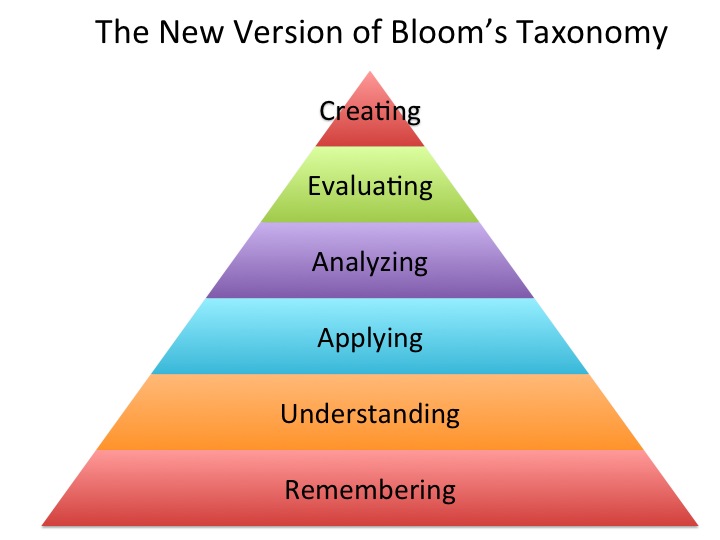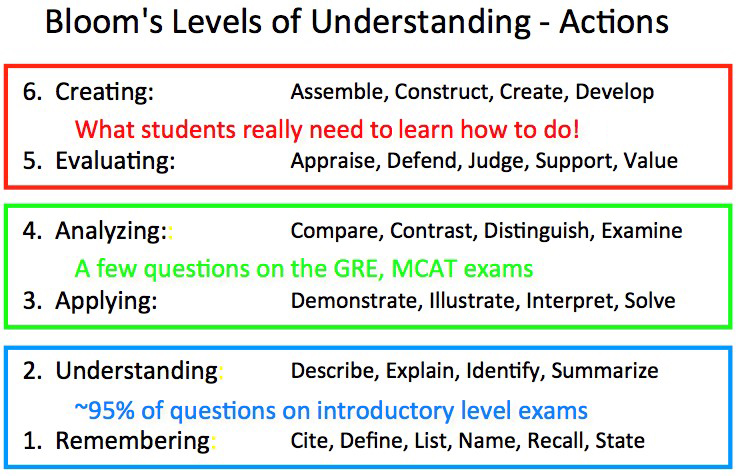A few years ago at an instructional workshop for university professors the following question was posed to the attendees: “What do you know about Bloom’s Taxonomy of the Cognitive Domain?” Most of the respondents answered, “Whose taxonomy of what?”
That answer indicates a general lack of knowledge about one of the most basic pedagogical principles in education. Here are some straightforward guidelines on what Bloom’s taxonomy is and how you can use it in your class.
In 1956, Benjamin Bloom (an American educational psychologist),with collaborators Max Englehart, Edward Furst, Walter Hill, and David Krathwohl, published a framework for categorizing educational goals: Taxonomy of Educational Objectives familiarly known as Bloom’s Taxonomy. The framework consisted of six major categories: Knowledge, Comprehension, Application, Analysis, Synthesis, and Evaluation. The categories after Knowledge were presented as “skills and abilities,” with the understanding that knowledge was the necessary precondition for putting these skills and abilities into practice.
 In 2001 Bloom’s taxonomy was revised by a group of cognitive psychologists, led by Lorin Anderson (a former student of Bloom). To update the taxonomy to reflect 21st century work the authors used verbs to re-label the six categories and included “action words” to describe the cognitive processes by which learners encounter and work with knowledge. The figures accompanying this article reflect that work. This revised Bloom’s taxonomy proves to be a very useful tool that can be used in all classrooms for several reasons listed below.
In 2001 Bloom’s taxonomy was revised by a group of cognitive psychologists, led by Lorin Anderson (a former student of Bloom). To update the taxonomy to reflect 21st century work the authors used verbs to re-label the six categories and included “action words” to describe the cognitive processes by which learners encounter and work with knowledge. The figures accompanying this article reflect that work. This revised Bloom’s taxonomy proves to be a very useful tool that can be used in all classrooms for several reasons listed below.
 About ninety percent of the questions students handle in any class are memory questions. The memory level is perfectly respectable and even essential in many learning situations. There are, however, disadvantages in using pure memory that an instructor should keep in mind. The memory level is a tool that promotes the use of short term memory, and the information may be forgotten if it is not used. Another problem with the memory level is that it does not guarantee understanding. We often assume that just because a student can cough up words, facts, and figures that s/he has “learned” and understands the material. That is simply not the case. By moving up the scale to teaching that involves students understanding, applying, and analyzing information, their learning outcomes will improve.
About ninety percent of the questions students handle in any class are memory questions. The memory level is perfectly respectable and even essential in many learning situations. There are, however, disadvantages in using pure memory that an instructor should keep in mind. The memory level is a tool that promotes the use of short term memory, and the information may be forgotten if it is not used. Another problem with the memory level is that it does not guarantee understanding. We often assume that just because a student can cough up words, facts, and figures that s/he has “learned” and understands the material. That is simply not the case. By moving up the scale to teaching that involves students understanding, applying, and analyzing information, their learning outcomes will improve.
That is not likely to happen, though, without some thoughtful preparation. In instructional design, questioning strategies can be as simple as the intentional progression of questions leading to higher levels of thinking and involvement. Bloom’s revised taxonomy can provide a framework for constructing those questions.
Some examples of how to incorporate Bloom’s taxonomy into classes include the following:
1. Creating Course Learning Objectives
In education, learning objectives are brief statements that describe what students will be expected to learn by the end of a course, unit, or class period. Instructors can benefit from using a framework to construct and organize learning objectives for themselves and for students. Having an organized set of learning objectives helps instructors plan and deliver appropriate instruction, design valid assessment tasks and strategies, and ensure that instruction and assessment are aligned with the objectives.
For example, learning objectives following Bloom’s revised taxonomy could be constructed as follows.
Students should be able to:
- Exhibit previously learned material by recalling facts, terms and basic concepts.
- Demonstrate understanding of facts and ideas by organizing, comparing, interpreting and giving descriptions and stating main ideas.
- Solve problems by applying acquired knowledge, facts, techniques and rules in a different way.
- Examine and break information into parts by identifying motives or causes; making inferences, and finding evidence to support generalizations.
- Compile information together in a different way by combining elements in a new pattern or proposing alternative solutions.
- Present and defend opinions by making judgments about information, validity of ideas or quality of work based on a set of criteria.
2. Asking Questions
In-class questioning can be varied from the most simple to those that require more thought. These questions can be categorized following Bloom’s hierarchy of cognitive skills. Here are some examples of questions asked about the story Goldilocks and the Three Bears. Do you remember the story line? The little girl Goldilocks visits the home of the papa, mamma, and baby bear where she sleeps in their beds, eats their food, and sits in their chairs.
Remembering: List the items used by Goldilocks while she was in the Bears’ house.
Understanding: Explain why Goldilocks liked Baby Bear’s chair the best?
Applying: Demonstrate what Goldilocks would use if she came to your house.
Analyzing: Compare this story to reality. What events could not really happen?
Evaluating: Propose how the story would be different if it was Goldilocks and the Three Fish.
Creating: Judge whether Goldilocks was good or bad. Defend your opinion.
3: Constructing Test or Exam Questions
This is a combination of the above two points. If the course is arranged around learning objectives, designed with Bloom’s taxonomy in mind, then those objectives can be used to construct test and exam questions. This process will ensure alignment between instruction and assessment and provide validity to your evaluation of students’ knowledge and skills.
Additional Resources
- Anderson, L. W., & Krathwohl, D. (Eds.). (2001). A taxonomy for learning, teaching, and assessing: A revision of Bloom’s taxonomy of educational objectives. New York: Longman.
- Bloom, B., Englehart, M. Furst, E., Hill, W., & Krathwohl, D. (1956). Taxonomy of educational objectives: The classification of educational goals. Handbook I: Cognitive domain. New York, Toronto: Longmans, Green.
- Davis, B.G (2009) Tools for Teaching, 2nd edition, Jossey-Bass, San Francisco
- Southey, R. (1837) The Three Bears. [Note this original version involves a nameless old woman instead of the little girl Goldilocks.]
Richard Shingles, Lecturer, Department of Biology
Director, TA Training Institute and The Summer Teaching Institute, Center for Educational Resources
Richard Shingles is a faculty member in the Biology department and also works with the Center for Educational Resources at Johns Hopkins University. He is the Director of the TA Training Institute and The Summer Teaching Institute on the Homewood campus of JHU. Dr. Shingles also provides pedagogical and technological support to instructional faculty, post-docs and graduate students
Image Source – CC Revised Bloom’s Taxonomy: Andrea Hernandez
Image Source – Bloom’s Levels of Understanding – Actions: Preparing Future Faculty Teaching Academy, Johns Hopkins University
http://www.cer.jhu.edu/graduatestudents/pffta.html

Pingback: Writing Course Learning Goals | The Innovative Instructor
For someone still trying to “learn the ropes and tools of pedagogy” this was very helpfull. Thanks for sharing.
It’s interesting (and probably telling) that the answer to the question of “Why use Bloom’s Taxonomy?” is usually something along the lines of “Because it’s a very useful tool.” Useful for what? Useful compared to what?
There are several other taxonomies of learning that can help those designing instruction ensure that students have the underlying support to reach the desired performance level. It is less useful for those not designing instruction, Essentially students must remember relevant facts in order to understand details regarding the subject at hand. I personally find Bloom’s Taxonomy a bit more approachable than the taxonomies developed by Gagné but Gagné’s domains of learning and their associated taxonomies can offer additional detail and nuance for those developing instruction.
Pingback: Resources For the Flipped Chemistry Classroom - Chemistry Is My Jam!
Pingback: Use your Azure skills to earn extra cash on the side! - How to Code .NET
Any chance you can change the typo in 6. Creating from “too” to “to?” Thank you!
Thanks for pointing out the typo. It has been corrected.
I believe the top two levels of the cognitive domain are interdependent, as whilst something is being created or developed there is a degree of evaluation going on and the purpose of evaluation is not really an end in itself, in that in any evaluation the desired outcome is improvement whether it’s of yourself or others. the two higher order skills then become an iterative process where thoughts and products are honed, with the aim of improving on previous iterations.
The relationship between test/exam questions and Bloom’s Taxonomy was quite informative. Also, the story of the three bears was an excellent example of how one can apply Bloom’s taxonomy. I will follow your instructions in my class.